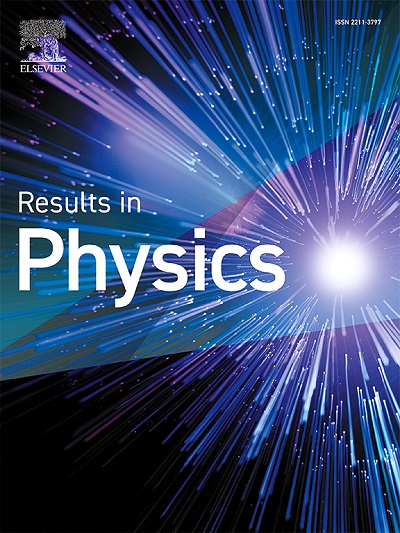原始和过渡金属掺杂石墨烯量子点作为H2O和NO2气体传感器的光学和电学性质:第一性原理研究
IF 4.4
2区 物理与天体物理
Q2 MATERIALS SCIENCE, MULTIDISCIPLINARY
引用次数: 0
摘要
在这项工作中,我们从理论上研究了六方石墨烯量子点(GQDs)在不同气体分子影响下的吸光度光谱变化,以评估其光学气体传感的潜力。利用密度泛函理论(DFT)计算分析了NO2和H2O等气体分子的吸光度。本文探讨了GQDs的光学和电学性质,重点研究了Pt和Pd掺杂剂对GQDs光谱特性的影响,强调了它们在提高吸附能和气体选择性方面的作用。我们的研究结果表明,GQDs结构中最有利的掺杂位点是碳六边形的中心(空心位点,H)。在原始GQDs的顶部位置(T)上,NO2的吸附能为- 0.16 eV,而Pt和Pd的掺杂显著提高了该值,达到约- 2.0 eV。此外,电荷转移计算表明,在Pt-GQDs中,从GQDs转移到过渡金属的电荷为- 0.562e,而在Pd-GQDs中,转移的电荷为- 0.203e。NO2和H2O在Pd-、pt掺杂和原始GQDs上最有利的吸附构型分别对应于O取向和H取向。在NO2吸附时观察到费米能级向导带的显著变化,而对H2O的影响最小。结果表明,Pt和pd掺杂的GQDs具有更高的吸附能,这表明它们在气敏应用中的影响。pd掺杂的GQDs对NO2具有较强的敏感性,是高效气体检测的理想材料。光学分析显示,在18 eV左右的吸收峰中存在蓝移,这为气体相互作用引起的电子跃迁提供了见解。此外,在Pt和pd掺杂的GQDs中,在低能量范围(2-5 eV)出现了新的吸收峰,表明它们适合在该电磁波谱区域内的气敏应用。本文章由计算机程序翻译,如有差异,请以英文原文为准。
Optical and electrical properties of pristine and transition Metals-doped graphene quantum dots as gas sensors toward H2O and NO2: A first principles study
In this work, we theoretically investigate the variations in the absorbance spectra of hexagonal graphene quantum dots (GQDs) under the influence of different gas molecules to evaluate their potential for optical gas sensing. The absorbance of gas molecules such as NO2 and H2O has been analyzed using density functional theory (DFT) calculations. This paper explores the optical and electrical properties of GQDs with a particular focus on the impact of Pt and Pd dopants on the spectral characteristics of GQDs, emphasizing their role in enhancing adsorption energies and gas selectivity. Our findings indicate that the most favorable doping site within the GQDs structure is the center of a carbon hexagon (hollow site, H). The adsorption energy of NO2 on pristine GQDs at the top site (T) is determined to be −0.16 eV, while doping with Pt and Pd significantly increases this value to approximately −2.0 eV. Additionally, charge transfer calculations reveal that in Pt-GQDs, −0.562e is transferred from the GQDs to the transition metal, whereas in Pd-GQDs, the transferred charge is −0.203e. The most favorable adsorption configurations for NO2 and H2O on Pd-, Pt-doped, and pristine GQDs correspond to the O and H orientations, respectively. A significant shift in the Fermi level toward the conduction band is observed upon NO2 adsorption, whereas the effect is minimal for H2O. The results demonstrate that Pt and Pd-doped GQDs exhibit higher adsorption energies, indicating their impact in gas-sensing applications. Pd-doped GQDs show stronger sensitivity to NO2, which makes it a promising candidate for efficient gas detection. Optical analysis reveals a blue shift in the absorption peaks around 18 eV, providing insights into electronic transitions induced by gas interactions. Furthermore, in Pt- and Pd-doped GQDs, new absorption peaks emerge in the low-energy range (2–5 eV), indicating they are suitable for gas sensing applications within this region of the electromagnetic spectrum.
求助全文
通过发布文献求助,成功后即可免费获取论文全文。
去求助
来源期刊

Results in Physics
MATERIALS SCIENCE, MULTIDISCIPLINARYPHYSIC-PHYSICS, MULTIDISCIPLINARY
CiteScore
8.70
自引率
9.40%
发文量
754
审稿时长
50 days
期刊介绍:
Results in Physics is an open access journal offering authors the opportunity to publish in all fundamental and interdisciplinary areas of physics, materials science, and applied physics. Papers of a theoretical, computational, and experimental nature are all welcome. Results in Physics accepts papers that are scientifically sound, technically correct and provide valuable new knowledge to the physics community. Topics such as three-dimensional flow and magnetohydrodynamics are not within the scope of Results in Physics.
Results in Physics welcomes three types of papers:
1. Full research papers
2. Microarticles: very short papers, no longer than two pages. They may consist of a single, but well-described piece of information, such as:
- Data and/or a plot plus a description
- Description of a new method or instrumentation
- Negative results
- Concept or design study
3. Letters to the Editor: Letters discussing a recent article published in Results in Physics are welcome. These are objective, constructive, or educational critiques of papers published in Results in Physics. Accepted letters will be sent to the author of the original paper for a response. Each letter and response is published together. Letters should be received within 8 weeks of the article''s publication. They should not exceed 750 words of text and 10 references.
 求助内容:
求助内容: 应助结果提醒方式:
应助结果提醒方式:


